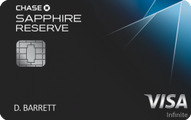Chase offers two top-of-the-line travel credit cards, the Sapphire Preferred and Sapphire Reserve credit cards. The first thing new applicants might notice is the markedly higher fee on the Reserve Card, $450 per year compared to $95 per year on the Sapphire Preferred.
Both cards come with many of the same general benefits. Both earn bonus points in the same categories, travel, and dining, both allow cardmembers to transfer points to Chase’s fleet of Ultimate Rewards partner airlines and hotel groups, and both come with essential travel benefits like lost baggage insurance, trip cancellation and delay protection and rental car coverage. Both earn bonuses that are often the same (but vary).
As of April 3, 2019, the Sapphire Preferred’s introductory bonus comes in at 60,000 points after new cardholders spend $4,000 in three months, while the Reserve’s welcome is 50,000 points after the same spending.

The handsome Chase Sapphire Reserve card.

The classic Chase Sapphire Preferred card.
On top of the similarities, both cards appeal and are available to roughly the same demographic. Some personal finance sites report that the Reserve card requires somewhat higher credit scores, but in my experience with friends and clients, anyone with a 690 or higher credit score and stable income is likely to be accepted on either card.
Deciding on a card, then, depends on one’s ability to use the Reserve card’s added perks.
I’ll argue that for the vast majority of travelers, those extras overwhelmingly make up for the higher fee, and then some. That said, lighter travelers and those with other high octane travel cards might not reap as much from the pricier Reserve card.
The Travel Credit

All types of transportation, including trains, buses and subways, qualify as travel with Chase cards.
The easiest Sapphire Reserve benefit to cash in is the $300 automatic travel credit. Unlike many cards, which require some form of activation or qualification to use a travel credit benefit, Chase just deducts the first $300 spent on any travel category each card renewal year.
Nearly anyone who moves can take advantage of this credit pretty quickly, as Chase includes a wide range of expenses in its travel category. To name a few:
- Public transportation tickets and passes
- Ride shares (Uber, Lyft) and taxis
- Bike share services
- Hotels and short-term rentals (AirBnB)
- Rental cars
- Regional and intercity bus and rail services
- Airfare, regardless of where it’s purchased
- Travel packages and tour packages purchased through a travel agent
- Cruises
Anyone who can spend $300 per year in any of the above categories can de-facto knock $300 off the tab of their Sapphire Reserve card, bringing the relative difference between the two cards to $55.
Bonus Earning Categories

For those who eat out a lot on their Chase card, the extra points earned on the Sapphire Reserve can quickly add up.
The Sapphire Preferred and Sapphire Reserve cards offer bonus earning on the same categories — travel and dining — but Reserve members earn an additional point on both, a 50-percent increase in earnings.
- Someone who spends $200 per month in dining and $3000 in travel per year would earn an additional 5,400 points per year, valued conservatively at $75 (potentially far more).
- Someone who has other cards that earn the same or more in these categories may not benefit as much from this bonus, due to less utilization.
Priority Pass Lounge Access (a.k.a Free Food)

The Plaza Premium Lounge at London Heathrow airport, a Priority Pass lounge. Image by Priority Pass
The Sapphire Reserve card includes a membership to Priority Pass, a network of more than 1,200 airport lounges around the world. The Sapphire Preferred card does not.
To understand the value of this benefit, one must consider how often they travel through an airport with a Priority Pass lounge or restaurant, and how likely they are in those scenarios to take advantage of amenities, like free meals, that would otherwise cost money. That means knowing whether airports you often fly from or through have lounges, which can be easily researched using Priority Pass’ lounge search tool.
A few scenarios to consider:
Connect through Atlanta three times per year, usually have a 90-minute layover or longer.
In this case, you’re going to be able to eat at The Club at ATL three times per year, cutting down what otherwise might be a $10 to $15 dining expense at the airport. In this case, Priority Pass is worth about $45 per year.
Live in Portland, Oregon, fly multiple times per month for work.
There are several Priority Pass lounges and restaurants at Portland International Airport, and restaurant guests enjoy up to $28 in dining credits on each visit. For a frequent flyer based at an airport like Portland, this benefit could add up to well over $200 or $300 in cash-equivalent benefits, making the Reserve Card a slam dunk choice.
Live in Cincinnati, take a few trips per year, typically connect in Detroit or Chicago.
Neither Cincinnati, Detroit or Chicago have Priority Pass lounges or restaurants. That would make it somewhat challenging to reap any constant value from a Priority Pass.
Have an American Express Platinum Card and a Citi ThankYou Prestige card and plan to keep at least one in addition to the Chase card.
Since both the Amex Platinum Card and Prestige card include lounge access that either matches or exceeds the Priority Pass offered by Chase, this benefit would have no value to such an individual.
Travel Portal Redemption Bonus (25%)
Chase Sapphire Reserve cardholders can redeem their points for more in equivalent cash when booking travel. Whereas Sapphire Preferred cardholders get to cash in points at 1.25 cents per point, Reserve cardholders net 1.5 cents per point through the portal.
The value of this benefit, as with Priority Pass, depends on how often it’s used.
Heavy points and miles hitters who cash in points exclusively for business and first class seats are unlikely to reap much from the travel portal bonus. Those who prefer to stretch their points out in economy, or book less expensive hotel rooms, can get a lot out of this bonus.
Rental Car Benefits – Sapphire Reserve
The Sapphire Reserve card comes with some added benefits when renting cars and booking hotel rooms. Again, the value of these benefits will depend on likely utilization.
Elite Status with Avis and National
Chase Sapphire Reserve cardholders enjoy elite status with Avis and National. That means car upgrades, faster service when picking up and dropping off cars, and bonus points in those loyalty programs.
Silvercar Discount
Sapphire Reserve cardholders get a 20 percent discount on rentals with Silvercar, the all-Audi app-based rental company in 20 cities.
Roadside Assistance
Sapphire Reserve cardholders get up to four annual roadside assistance calls comped up to $50. Sapphire Preferred cardholders have access to the same service, but pay $59.95 per call.
Rental Car Insurance
Both cards offer primary rental car insurance (i.e., collision insurance), but the Sapphire Preferred does not cover certain luxury and exotic car rentals. The Sapphire Reserve Card covers all rentals.
Global Entry and TSA PreCheck
The Sapphire Reserve Card includes a $100 credit that can cover application fees for either TSA PreCheck or Global Entry (which includes PreCheck).
Which Is Better, Sapphire Preferred or Sapphire Reserve?
In most cases, I hold steady that the Sapphire Reserve‘s added benefits more than account for the additional fee. Pretty much anyone who leaves home can burn through the automatic travel credit, and anyone who regularly uses the card at restaurants or on travel will make up the rest in additional bonus points.
Throw in a few Priority Pass lounge visits, and the Reserve is far in the green.
What Is Sapphire Preferred Good For, Then
Those who have other travel rewards credit cards, matching some of the benefits and bonuses that come with the Sapphire Reserve Card, might be better served by the cheaper Preferred card. If your dining is going on an American Express Gold Card, and airfare is booked through a Platinum Card, neither the lounge benefit nor airfare bonus points benefit come into play.
In that case, the Sapphire Preferred card provides access to Chase’s versatile Ultimate Rewards portal, not to mention a handsome introductory bonus opportunity, at a more affordable rate.
The responses below are not provided or commissioned by the bank advertiser. Responses have not been reviewed, approved or otherwise endorsed by the bank advertiser. It is not the bank advertiser's responsibility to ensure all posts and/or questions are answered.